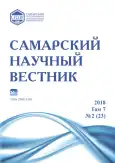Ecological and social «risk factors» for students’ healthy lifestyle promotion
- Authors: Shvechikhina Y.V.1, Kavelenova L.M.1, Rytov G.L.1
-
Affiliations:
- Samara National Research University
- Issue: Vol 7, No 2 (2018)
- Pages: 133-138
- Section: 03.02.00 – General Biology
- URL: https://journals.rcsi.science/2309-4370/article/view/21752
- DOI: https://doi.org/10.17816/snv201872127
- ID: 21752
Cite item
Full Text
Abstract
The most important condition for the sustainable development of socio-ecological and economic systems at all levels, from regional to national, is undoubtedly a balanced socio-demographic development. It is connected with the presence of sufficiently numerous social groups of a professionally competent, physically and morally healthy population that also serves as the basis for the national security of the country. The number of students in the Samara Region at the level of more than 100 thousand people provides good opportunities for qualified professionals’ training, whose activities are not limited to the space of the Samara Region. In addition to acquiring professional knowledge, skills and general and special competencies development, young people studying in higher education must also acquire a deep and conscious motivation to lead a healthy lifestyle. In this paper, we present a part of the comprehensive research that we are already carrying out, related to the ecology-population basics of student health status promotion. An important moment in this respect is, according to WHO, the fight against obesity, and one of the relatively accessible indicators is the body mass index (BMI). For model groups of Samara University students the distribution according to the body mass index shows a prevalence of the normal level of the indicator (from 20 to 24) – for young men and the indicator 20 (the lower limit of the norm) for girls. This is a good «starting point» for motivating students to lead a healthy lifestyle in the future.
Full Text
##article.viewOnOriginalSite##About the authors
Yulia Vladimirovna Shvechikhina
Samara National Research University
Email: schwechixina2008@mail.ru
postgraduate student of Ecology, Botany and Nature Protection Department
Russian Federation, SamaraLyudmila Mikhailovna Kavelenova
Samara National Research University
Email: lkavelenova@mail.ru
doctor of biological sciences, professor, head of Ecology, Botany and Nature Protection Department
Russian Federation, SamaraGleb Lvovich Rytov
Samara National Research University
Author for correspondence.
Email: biofak@samsu.ru
candidate of pedagogical sciences, associate professor, head of Biological Department
Russian Federation, SamaraReferences
- Демографические вызовы России // Экспертно-аналитический доклад. Человеческий капитал. М.: Центр стратегических разработок, 2017. 70 с.
- Прогноз по демографической ситуации в России неутешительный // Демоскоп weekly № 753-754. 18-31 декабря 2017.
- Государственный доклад о состоянии окружающей среды и природных ресурсов Самарской области за 2015 год. Вып. 25. Самара, 2016. 298 с.
- Экономическая энциклопедия регионов России. Самарская область. М.: ЗАО «Издательство «Экономика», 2007. 396 с.
- Численность учащейся молодежи образовательных учреждений Российской Федерации: Среднесрочный прогноз до 2014 года и оценка тенденций до 2025 года / под ред. Ф.Э. Шереги и А.Л. Алефьева. М.: ЦСПиМ, 2010. 320 с.
- Регионы России. Социально-экономические показатели // Стат. сб. М.: Росстат, 2017. С. 1402.
- Регионы России. Основные характеристики субъектов Российской Федерации // Стат. сб. М.: Росстат, 2017. С. 751.
- Давиденко Д.Н., Щедрин Ю.Н., Щеголев В.А. Здоровье и образ жизни студентов / под общ. ред. профессора Д.Н. Давиденко: учебное пособие. СПб.: СПбГУИТМО, 2005. 124 с.
- Бароненко В.А., Рапопорт Л.А. Здоровье и физическая культура студента. М.: Альфа-М; ИНФРА-М, 2012. 269 с.
- Кобыляцкая И.А., Осыкина А.С., Шкатова Е.Ю. Состояние здоровья студенческой молодежи // Успехи современного естествознания. 2015. № 5. С. 74-75.
- Не остаться в живых. 99 способов сократить жизнь. М.: Эксмо, 2013. 224 с.
- Черняева Т.К. Методические основы изучения и оценки негативного воздействия факторов окружающей среды на состояние здоровья населения: лекция. Н. Новгород: Изд-во Нижегородский гос. медицинской академии, 2013. 40 с.
- Прохоров Б.Б. Введение в экологию человека: Социально-демографический аспект. М.: Изд-во МНЭПУ, 1995. 101 с.
- Экология человека и перспективы цивилизации / под ред. Б.Б. Прохорова. М.: Мысль, 1994. 200 с.
- Семенов В.Е. Социально-психологические аспекты экологии человека в большом городе // Экология человека в больших городах. Л.: Зоологический институт АН СССР, 1998. 160 с.
- Швечихина Ю.В., Рытов Г.Л., Кавеленова Л.М. К изучению эколого-социальных аспектов формирования статуса здоровья студенческой молодежи // Биодиагностика состояния природных и природно-техногенных систем: мат-лы ХIV всерос. науч.-практ. конф. c междунар. уч. Кн. 1. Киров: ООО «Издательство «Радуга-ПРЕСС», 2016. С. 361-364.
- Швечихина Ю.В., Кавеленова Л.М., Вартанова Н.Б., Рытов Г.Л. Первичные результаты оценки биоэкологического статуса псевдопопуляционных групп студентов (на примере биологического факультета Самарского университета) // Вестник молодых ученых и специалистов Самарского университета. 2017. Т. 11, № 2. С. 43.
- Швечихина Ю.В., Рытов Г.Л., Кавеленова Л.М., Шуватова Л.В. Эколого-социальные аспекты формирования статуса здоровья студенческой молодежи как составляющая перспективы устойчивого развития социо-эколого-экономических систем // Инновационные подходы к обеспечению устойчивого развития социо-эколого-экономических систем: сб. ст. 5-й междунар. конф. Тольятти: ИЭВБ РАН, 2018. С. 306.
- Teixeira F.V., Pais-Ribeiro J.L., da Costa Maia A.R. Beliefs and practices of healthcare providers regarding obesity: a systematic review // Rev. Assoc. Med. Brasil. 2011. Vol. 58 (2). P. 254-262.
- Knapper J.N., Ghasemzadeh N., Khayata M., Patel S.P., Quyyumi A.A., Mendis S., Mensah G.A., Taubert K., Sperling L.S. Time to Change Our Focus. Defining, Promoting, and impacting Cardiovascular Population Health // Journal of American college of cardiology. 2015. Vol. 66, № 8. P. 960-971.
- Расчет индекса массы тела [Электронный ресурс] // Медицинская информационно-консультационная система. - http://ill.ru/cgi-bin/form.exp.bmi.pl.
Supplementary files









